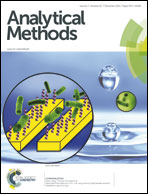The art of signal transforming: electrodes and their smart applications in electrochemical sensing
Abstract
Electrochemical sensors provide some advantages over optical-based sensors because they can offer comparable instrumental sensitivity and are more amenable to miniaturization. Electrodes are a necessary and critical component in the design of electrochemical biosensors. Herein, the applications of several novel electrodes are covered in this manuscript, including screen-printed electrodes (SPEs), interdigitated microelectrodes (IDμEs), paper microelectrodes and nanoelectrodes. Microelectrodes and nanoelectrodes are discussed in detail due to their unique properties. Various well-developed and recognized elements were utilized for biosensor construction, as is indicated in this review. Different immobilization methods can be utilized to improve the quality and level of detection. Many nanomaterials, such as carbon nanotubes (CNTs), graphene, metal–organic frameworks (MOFs), and hollow nanoparticles (HNPs), have been used, which have the potential to improve the sensitivity of the electrochemical biosensors. This manuscript highlights the effect of rapid advancement of nanotechnology and microfluidics and their application to diverse fields of scientific research as well as additional applications, challenges, and perspectives.


 Please wait while we load your content...
Please wait while we load your content...